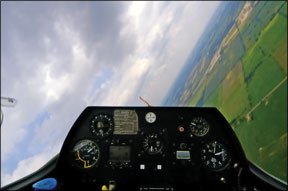According to the AOPA Air Safety Foundations 2007 Nall Report, you have a 57.4 percent chance of dying if you lose control while maneuvering an airplane, up from 50.5 percent in the reports 2005 edition. Maneuvering describes a host of flight operations including aggressive turns from base to final, confined-area course 288 reversals and retreats to the runway following an engine failure. In other words, turns. Why cant Johnny turn safely? One reason might be losing understanding of and appreciation for the dynamics of a turn, regardless of bank angle, airspeed or pitch. Lets take a look. Back to School Every flight we take involves turning-an act so basic, yet so often misunderstood. Cory Lidle and many less-famous pilots are proof that what you dont know about turning can indeed kill you. Perhaps the least static of the four basic flight maneuvers-including climbs, descents, plus straight and level-turns present a dynamic all their own. Understanding their nuances will help you perform them. During your last check ride or flight review, you were tested on your ability to turn the airplane. The practical test standards for the sport, private, commercial and airline transport pilot certificates require an applicant to be able to control the airplane through coordinated shallow-to-medium bank turns, and also to explain and demonstrate steep turns. In a steep turn, the pilot rolls the aircraft into a 40-60 degree bank while maintaining altitude within 100 feet and airspeed within 10 knots. The point of this exercise is for the pilot to prove that he understands the dynamic relationship between the forces acting upon an airplane in turning flight-not to qualify for the Reno Air Races. In a turn, the plane must not only support itself vertically, but must also pull itself through the turn by directing some lift in a horizontal direction. We make that extra lift by pulling back on the yoke or stick to increase the airplanes angle of attack. If we dont make extra lift, the airplane descends in the turn because we are relieving it of the need to support that extra weight, and the wing loading decreases. This is an important concept, one you can use to your advantage when trying to turn around in a tight space. Pilots learn early in their flight training that stall speed increases with weight. Whether that weight is physically added by piling on baggage, or artificially through the extra gravitational force exerted in a turn, is irrelevant as far as the airplane is concerned. As bank angle increases, so does load factor and with it, the margin between your current airspeed and the stall decreases. Just look in the Performance section of your airplanes POH. The bottom line is that if you need to bank steeply in a confined space, you have essentially two choices: Keep the altitude and accept a higher stall speed (a speed closer to your current air speed), or lose altitude and lower the stall speed (fatten the cushion between your current speed and the stall speed). Remember that at any given bank angle, the radius of the turn increases with the square of the airspeed-which is why a Cessna Citation flies a faster, wider traffic pattern than a Cessna 150. So if youre short on space, increasing your airspeed is probably not an option. But you may have altitude to lose, and extending flaps can further reduce your stall speed, thus increasing your margin of safety above a stall. Cory Lidle had neither altitude nor space available in the narrow East River corridor. Think Before you Bank Steep turns are rarely necessary outside the realm of a check ride or a flight review. Thirty degrees of bank is more than sufficient to fly a traffic pattern, and 15-20 degrees of bank is all it takes to accomplish a standard rate turn on instruments in most light general aviation aircraft. So why do pilots lose control of airplanes while turning if their aptitude exceeds their daily experience? What can you do to stay safe while turning-especially in response to an immediate threat such as a potential mid-air collision or terrain? Sudden, evasive maneuvers notwithstanding, a pilot usually has time to consider how a heading change is going to be accomplished, and can use a shallow bank angle to get there. When approaching a holding fix, an instrument pilot can choose to join the holding pattern straight in or via some form of teardrop entry. Of course, ATC doesnt really care how you enter the hold as long as you maintain your altitude and stay within the protected area, flying in the correct direction around the racetrack. A VFR pilot approaching a non-towered airport has several choices for how to enter the traffic pattern, and should pick the one that requires the least maneuvering and complies with AIM-recommended practices. Pilots need to maintain a constant awareness of when a heading change will, for whatever reason, require a bank of more than 30 degrees. If it does, the pilot should consider an alternative action. The classic stall-spin accident scenario begins when a pilot misjudges the wind in the traffic pattern and, with a tailwind on the base leg, overshoots the final approach course and enters an uncoordinated steep turn in a futile-and often fatal-attempt to realign with the runway. One has to wonder if pilots who died this way thought as they were spiraling toward the ground, “Why didnt I just go around?” It was not the steep turn itself that killed them, but poor decisions coupled with poor technique. Remember the Rudder A discussion of turns would be incomplete without mentioning the rudder. As Wolfgang Langewieshe so elegantly stated in his 1944 book 
Meredith Saini is a freelance aviation writer and flight instructor flying from the Gaithersburg, Md., area.




